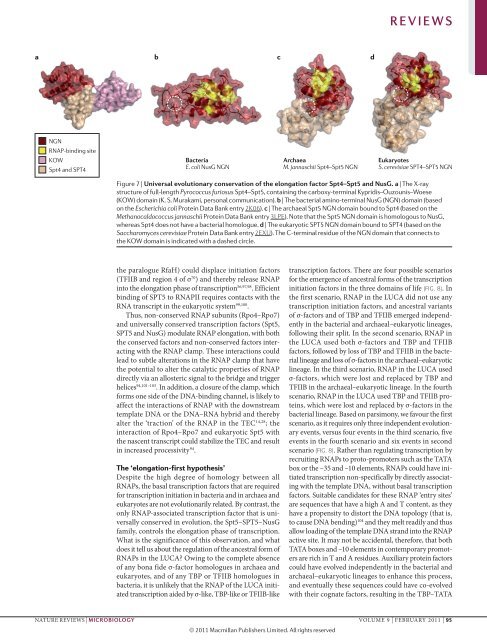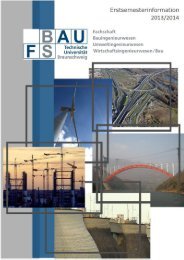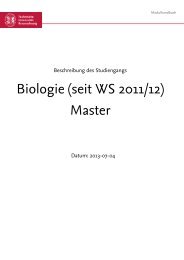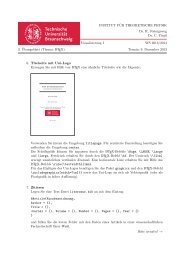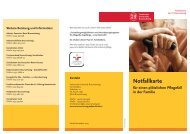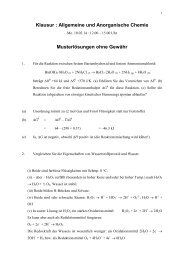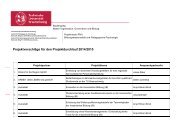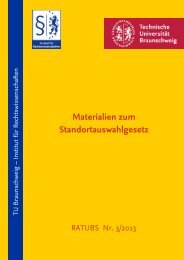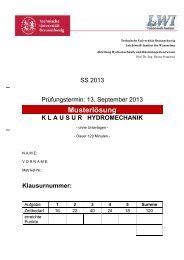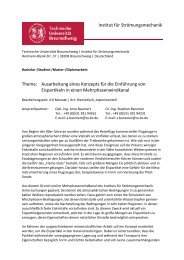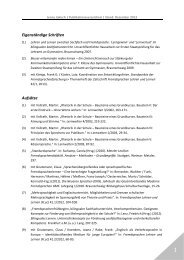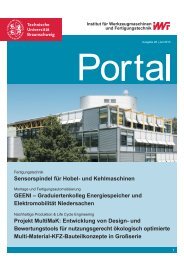L - Technische Universität Braunschweig
L - Technische Universität Braunschweig
L - Technische Universität Braunschweig
Create successful ePaper yourself
Turn your PDF publications into a flip-book with our unique Google optimized e-Paper software.
REVIEWS<br />
a b c d<br />
NGN<br />
RNAP-binding site<br />
KOW<br />
Spt4 and SPT4<br />
Bacteria<br />
E. coli NusG NGN<br />
Archaea<br />
M. jannaschii Spt4–Spt5 NGN<br />
Eukaryotes<br />
S. cerevisiae SPT4–SPT5 NGN<br />
Figure 7 | Universal evolutionary conservation of the elongation factor Spt4–Spt5 and NusG. a | The X‐ray<br />
structure of full-length Pyrococcus furiosus Spt4–Spt5, containing the carboxy‐terminal Kypridis–Ouzounis–Woese<br />
Nature Reviews | Microbiology<br />
(KOW) domain (K. S. Murakami, personal communication). b | The bacterial amino-terminal NusG (NGN) domain (based<br />
on the Escherichia coli Protein Data Bank entry 2K06). c | The archaeal Spt5 NGN domain bound to Spt4 (based on the<br />
Methanocaldococcus jannaschii Protein Data Bank entry 3LPE). Note that the Spt5 NGN domain is homologous to NusG,<br />
whereas Spt4 does not have a bacterial homologue. d | The eukaryotic SPT5 NGN domain bound to SPT4 (based on the<br />
Saccharomyces cerevisiae Protein Data Bank entry 2EXU). The C‐terminal residue of the NGN domain that connects to<br />
the KOW domain is indicated with a dashed circle.<br />
the paralogue RfaH) could displace initiation factors<br />
(TFIIB and region 4 of σ 70 ) and thereby release RNAP<br />
into the elongation phase of transcription 56,97,98 . Efficient<br />
binding of SPT5 to RNAPII requires contacts with the<br />
RNA transcript in the eukaryotic system 99,100 .<br />
Thus, non-conserved RNAP subunits (Rpo4–Rpo7)<br />
and universally conserved transcription factors (Spt5,<br />
SPT5 and NusG) modulate RNAP elongation, with both<br />
the conserved factors and non-conserved factors interacting<br />
with the RNAP clamp. These interactions could<br />
lead to subtle alterations in the RNAP clamp that have<br />
the potential to alter the catalytic properties of RNAP<br />
directly via an allosteric signal to the bridge and trigger<br />
helices 94,101–103 . In addition, a closure of the clamp, which<br />
forms one side of the DNA-binding channel, is likely to<br />
affect the interactions of RNAP with the downstream<br />
template DNA or the DNA–RNA hybrid and thereby<br />
alter the ‘traction’ of the RNAP in the TEC 14,28 ; the<br />
interaction of Rpo4–Rpo7 and eukaryotic Spt5 with<br />
the nascent transcript could stabilize the TEC and result<br />
in increased processivity 94 .<br />
The ‘elongation-first hypothesis’<br />
Despite the high degree of homology between all<br />
RNAPs, the basal transcription factors that are required<br />
for transcription initiation in bacteria and in archaea and<br />
eukaryotes are not evolutionarily related. By contrast, the<br />
only RNAP-associated transcription factor that is universally<br />
conserved in evolution, the Spt5–SPT5–NusG<br />
family, controls the elongation phase of transcription.<br />
What is the significance of this observation, and what<br />
does it tell us about the regulation of the ancestral form of<br />
RNAPs in the LUCA? Owing to the complete absence<br />
of any bona fide σ-factor homologues in archaea and<br />
eukaryotes, and of any TBP or TFIIB homologues in<br />
bacteria, it is unlikely that the RNAP of the LUCA initiated<br />
transcription aided by σ‐like, TBP-like or TFIIB-like<br />
transcription factors. There are four possible scenarios<br />
for the emergence of ancestral forms of the transcription<br />
initiation factors in the three domains of life (FIG. 8). In<br />
the first scenario, RNAP in the LUCA did not use any<br />
transcription initiation factors, and ancestral variants<br />
of σ-factors and of TBP and TFIIB emerged independently<br />
in the bacterial and archaeal–eukaryotic lineages,<br />
following their split. In the second scenario, RNAP in<br />
the LUCA used both σ-factors and TBP and TFIIB<br />
factors, followed by loss of TBP and TFIIB in the bacterial<br />
lineage and loss of σ-factors in the archaeal–eukaryotic<br />
lineage. In the third scenario, RNAP in the LUCA used<br />
σ-factors, which were lost and replaced by TBP and<br />
TFIIB in the archaeal–eukaryotic lineage. In the fourth<br />
scenario, RNAP in the LUCA used TBP and TFIIB proteins,<br />
which were lost and replaced by σ-factors in the<br />
bacterial lineage. Based on parsimony, we favour the first<br />
scenario, as it requires only three independent evolutionary<br />
events, versus four events in the third scenario, five<br />
events in the fourth scenario and six events in second<br />
scenario (FIG. 8). Rather than regulating transcription by<br />
recruiting RNAPs to proto-promoters such as the TATA<br />
box or the –35 and –10 elements, RNAPs could have initiated<br />
transcription non-specifically by directly associating<br />
with the template DNA, without basal transcription<br />
factors. Suitable candidates for these RNAP ‘entry sites’<br />
are sequences that have a high A and T content, as they<br />
have a propensity to distort the DNA topology (that is,<br />
to cause DNA bending) 104 and they melt readily and thus<br />
allow loading of the template DNA strand into the RNAP<br />
active site. It may not be accidental, therefore, that both<br />
TATA boxes and –10 elements in contemporary promoters<br />
are rich in T and A residues. Auxiliary protein factors<br />
could have evolved independently in the bacterial and<br />
archaeal–eukaryotic lineages to enhance this process,<br />
and eventually these sequences could have co-evolved<br />
with their cognate factors, resulting in the TBP–TATA<br />
nature reviews | Microbiology Volume 9 | february 2011 | 95<br />
© 2011 Macmillan Publishers Limited. All rights reserved


